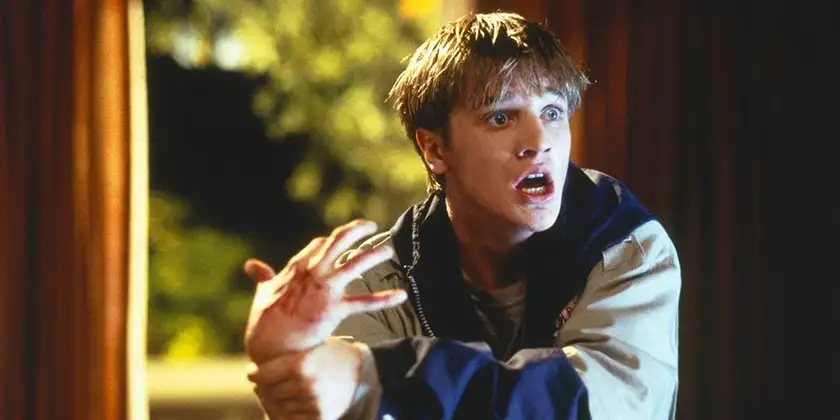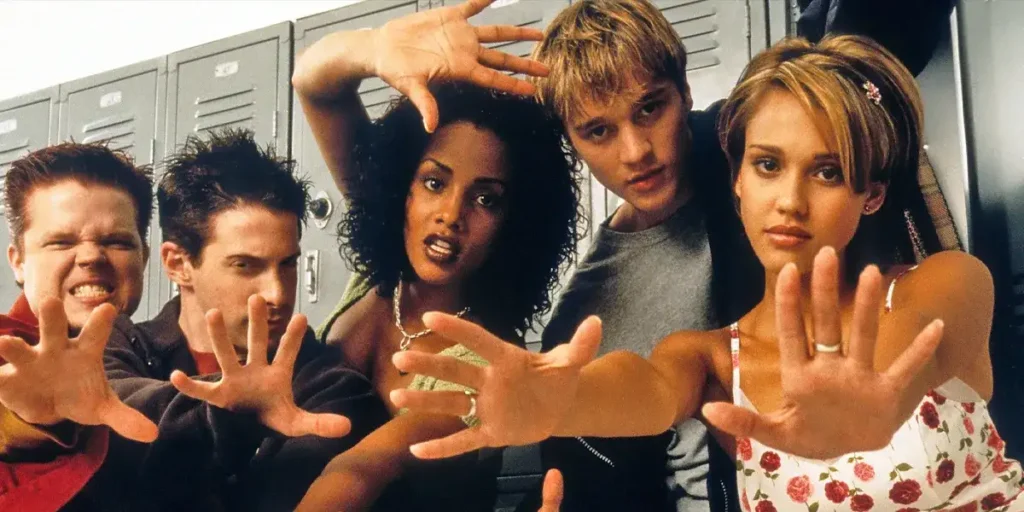Idle Hands is a quirky mixture of slapstick comedy and horror tropes that melds together seamlessly, and it remains deserving of its cult favourite status.
Director: Rodman Flender
Genres: Horror, Teen, Zombie, Stoner Comedy, Body Horror
Run Time: 92′
U.S. Release: April 30, 1999
U.K. Release: November 5, 1999
Where to Watch: on digital & VOD
Rodman Flender’s Idle Hands makes me yearn for a time I’ve never known. If you were born in the late ’90s, there’s a good chance you were part of a generation that endured a period of technological transition. As late millennials (depending on where you position the goalposts), we surfed the wave of internet popularisation. We moved through school as mobile phones became less durable, more advanced and widely owned.
We remember noisy modems, dial-up internet, and fast falling into the gravitational pull of social media dependence.
Movies from the 1990s present the teenage experience very differently: young people seek the physical company of their peers, and hangouts are more about preserving the moment in memory than on camera. Idle Hands is one such movie that gives us a look back at an era long lost to time, only this rose-tinted visage of the past is plagued by something more deadly than an aspiring influencer with TikTok on quick-draw.
Playing on the famous phrase “idle hands are the devil’s playthings,” which stretches back on historical record at least as far as Geoffrey Chaucer’s “Canterbury Tales”, Idle Hands tells the madcap genre-bending story of a simple slacker. Anton (Devon Sawa, Final Destination) is a listless teen whose daily motivation consists of smoking marijuana and watching TV with his friends Mick (Seth Green, Austin Powers) and Pnub (Elden Henson, Daredevil), and fawning over Molly (Jessica Alba, Fantastic Four), the cute neighbour across the street. Life for our messy-haired protagonist is slow and sedentary, so much so that he doesn’t notice a warning on the news that a mystery serial killer is active and on the loose in his area.
It takes until Anton discovers his parents iced in cold blood for him to grasp the severity of the situation, while at the same he’s forced to reckon with the bewildering truth that the murderer may be himself. Or, rather, the murderer is part of himself, as his right hand has somehow become possessed and has been acting murderously of its own volition. Suddenly, all those close to Anton are in mortal danger, and he must wrestle his homicidal limb to stop the murder spree and save the girl he loves.

Idle Hands is built on the backbone of absurdist comedy, and it frequently melds humour and horror together in a way that certainly appears to favour the former. There’s no doubt the movie owes plenty to Sam Raimi’s Evil Dead II, with Bruce Campbell’s iconic frenzied performance either serving as direct inspiration for Sawa’s physical acting or providing the DNA through cultural osmosis. Sawa throws himself around like a rag doll as he battles his possessed hand on multiple occasions, such as trying (and failing) to prevent it from butchering his friends and successfully (for the most part) attempting to tie it to Molly’s bedframe to prevent it from choking her to death as they share their first intimate moment.
It would be easy to punch down at Idle Hands for leaning on zonked-out stoner characterisations and crude humour to elicit simple laughs, but almost all the actors deliver whip-smart dialogue with too much cutting comedic edge for the brainless critique to hold water. Such an outlandish concept was never likely to be intellectually stimulating, but the beauty and depth of genre filmmaking allow for all manner of eclectic, off-kilter storytelling to find a dedicated audience. This was particularly true of the ’90s and late ’80s, which saw plenty of idiosyncratic horror comedy concepts come to life, from Death Becomes Her and Frankenhooker to Killer Klowns from Outer Space and Jack Frost.
Idle Hands benefitted from the wholesale resuscitation of the slasher genre in the late ’90s courtesy of Kevin Williamson and Wes Craven, but it thankfully doesn’t settle for being a carbon copy of Scream as many of its contemporaries did. Of the many slashers to be released post-revival, Rodman’s fourth feature possesses a distinctive identity. Unlike notable stoner comedies Harold & Kumar Go to White Castle, How High and Dude Where’s My Car? that would be released in the handful of years after it, Idle Hands uses stoner conventions merely as a foundational structure for horror to take root. It doesn’t shirk on gore and blood splatter either, packaging at least one impaling, scalping and decapitation each between the infrequently dated jokes and ganja gags.
These jokes and sequences of grisly crimson carnage are set against a colourful seasonal backdrop, with the movie using a large Halloween dance as its climactic centrepiece, awash with explosions of colour and giallo-inspired lighting. One might be forgiven for expecting less of Idle Hands due to the initial sluggish pacing, but the larger appeal and snug ambience begin to take form once the film morphs beyond its stoner comedy trappings. It would hardly be accurate to label the movie stylish either, but enough is going on from a visual standpoint, particularly regarding the excellent practical effects, to elevate proceedings and prevent the image from feeling like a flat imitation of its influences.
For how well Idle Hands manages to infuse horror and comedy, though, it does admittedly fall short in other areas, namely both the romantic and druidic lore subplots. Alba’s Molly is disappointingly underdeveloped as the object of Anton’s desires, and the fact she exhibits any lustful interest in a burnout blood-stained boy stretches the realm of reality. Beyond how unrealistic her attraction to Anton is, it’s more problematic that her desire for his attention amounts to the entire sum of her characterisation. The druidic subplot is likewise undercooked, with high priestess Debi LeCure (Vivica A. Fox, Kill Bill) sporadically shown to be on the hunt for the evil behind Anton’s possessed hand in such a way that it only ever feels like a late-stage addition to the plot.
Idle Hands was subject to a rough release that saw it removed from theatres, mostly panned by critics and called out publicly in Congress, falling victim to the persecution of perceived violent media due to the proximity of its release to the tragic events of Columbine. Since its release the movie has managed to develop a cult following, and given how it serves as a time capsule for the late ’90s, that shouldn’t come as any great surprise. From the outdated wardrobe to a punk-dominated soundtrack that boasts tracks from such artists as The Offspring and the Ramones, Idle Hands gleefully whisks us back to a time when campy yet earnest genre chaos didn’t feel quite so novelty.
It’s an underappreciated horror gem that too often finds itself lambasted because of its goofy tone and seemingly frivolous plot, but that’s precisely why it has attained cult status and remains beloved by the few who embrace the movie on its own terms.
Idle Hands is now available to watch on digital and on demand.

